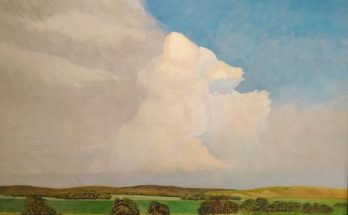by Clare Howell
Can a novel published in 1927 about two French priests in the wilds of the New Mexico territory a century earlier resonate with the modern reader? Can we be transported to that remote time and culture and feel alive in it, experience the strange immediacy of life among Native Americans and Mexicans? Yes! Thanks to the great novelist of the plains, Willa Cather (1873-1947). Virginia-born, Nebraska-raised, she spent seven years roaming the still undeveloped southwest United States researching this story; she uses real priests fictionalized as Bishop Jean Marie Latour and Father Joseph Vaillant as her protagonists.
There’s no major conflict or resolution, no major plot twists, just the accretion of character and fate through closely observed individual lives. This book stays in memory long after more fulsome adventures of action and intrigue are forgotten. Landscape is character here. It defines the exertions of our protagonists and shapes the lives of its Mexican and indigenous people. Time blended with geography is destiny.
There’s adventure, mostly from living in the upper Sonoran desert with no electricity, postal service, penicillin, railroad, law enforcement, or engine power. Life’s great going is at the pace of an ambling mule: Bishop Latour and Jacinto, his young aide, lose their mules and barely survive a blinding snowstorm in the mountains when Jacinto locates a hidden place of native ritual celebrations; the priests are saved by a young Mexican woman, Magdalena, from her cutthroat husband, Buck Scales; rivaling priests and those grown old and corrupt have to be dealt with. The daily taking of pains that accumulate over the seasons of a lifetime form the spine of this story.

Traveling over vast distances is arduous and filled with uncertainty. After a year getting to the vicarage in Santa Fe—down the Ohio and Mississippi Rivers to New Orleans from the last rail link at Cincinnati, to Galveston by steamer, then overland 925 miles through San Antonio to New Mexico—Latour and Vaillant are rebuffed by priests when they arrive, saying they are bound to the Bishop of Durango. So Latour sets out on horseback the 915 miles to Durango in old Mexico to confer with the Bishop there. Returning, he’s stunned by the setting:
“The weather alternated between blinding sandstorms and brilliant sunlight. The sky was full of motion and change as the desert beneath it was monotonous and still—and there was so much sky, more than at sea…The plain was there, under one’s feet, but what one saw when one looked about was that brilliant blue world of stinging air and moving cloud…. Elsewhere the sky is the roof of the world; but here the earth was the floor of the sky.”
The native inhabitants, the Hopi, Navajo, and Pueblo, are inscrutable to Europeans. “When they left the tree or sand dune that had sheltered them for the night, the Navajo was careful to obliterate every trace of their occupation…Since this was exactly Jacinto’s procedure, Father Latour judged that, just as it was the white man’s way to assert himself in any landscape, to change it, make it over…it was the Indian’s way to pass through a country without disturbing anything…like fish through water, or birds through the air…not attempting to improve the land, they never desecrated it.”
Willa Cather was a woman of her time and place, as Latour and Vaillant were of theirs. The implicit racism is obvious. Father Vaillant: “The more I work with Mexicans, the more I believe it was them our savior bore in mind when he said: ‘Unless ye become as little children.’ He was thinking of people who were not clever in the things of this world, whose minds are not upon gain and worldly advancement.” The awe-inspiring thing about our protagonists is their courage and scrupulous honesty, their dedication and persistence in the face of bewildering odds in spreading an ineffable goal: the realization of Faith.
Death comes for the Archbishop after a long life when he is retired to his small adobe house near Santa Fe, his body worn out, tending his gardens and training new priests. Father Vaillant has already passed away. While riding in an open buggy one January, Latour is drenched by a violent rainstorm. When he develops pneumonia, his attendant expresses fear that it will kill him. The Archbishop smiles and says, “I shall not die of a cold, young man. I shall die of having lived.”




